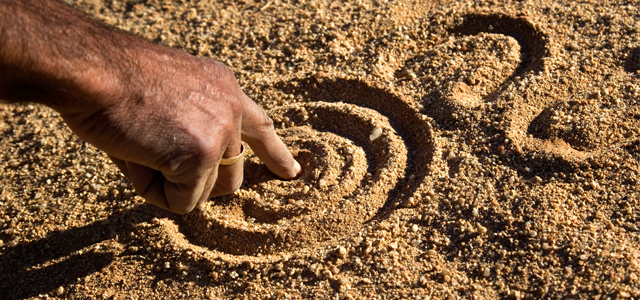The Original Australians: Revised and Updated Edition, Josephine Flood, Allen and Unwin.
The Heartbeat of Wounded Knee, David Treuer, Corsair.
Josephine Flood is impressed by indigenous culture’s resilience. It is initially surprising but perhaps appropriate then that she begins her history with the relationship between indigenous people and colonists, because resilience is in the face of British colonisation and, today, history wars and issues such as Adam Goodes’ forced exit from football.
Her book is a celebratory account of Aboriginal Australia for the general reader, and she covers wide and rich territory with economical pace. She aims for a conciliatory, uncontroversial, impartial tone, focussing on agreed-upon facts and trying to avoid the charged language of genocide, invasion and the like. Exaggeration is unhelpful to reconciliation, she says. Yet the very nature of what is exaggerated and what is fact is itself controversial, and she ends up making some surprisingly blunt judgements, perhaps emphasising how hard it is for Australians to agree on our indigenous history, despite good intentions.
Although Flood sees European settlement as often disastrous, she plays down the idea of frontier wars and says that germs not guns caused most fatalities of indigenous people. But there were virtual wars over land, as colonists pushed further inland. She says there is little evidence of indiscriminate slaughter but then quotes an early settler describing exactly that. She writes about the natural human desire for exploration and different understandings of land and property and inevitable misunderstandings, but there remains the fact that Europeans pushed aboriginal people off land that was clearly occupied. She writes that land was ‘shared’ and that there were good relations between some settlers and aborigines, yet hunting grounds were disrupted, native populations uprooted and land effectively stolen.
Flood uses the same logic on the issue of the ‘stolen generations’, arguing that technically they weren’t stolen because removal was not illegal. She is empathetic over the trauma of removal and an advocate for the improvement of indigenous lives, so such legal distinctions seem unnecessarily decisive.
While outlining the longevity and sophistication of indigenous culture, Flood subscribes to the older view that aborigines didn’t practise agriculture, even if others, including Bruce Pascoe in his book Dark Emu, don’t see it that way. Sometimes it feels as if hers is a view of indigenous culture through European eyes, which is something aboriginal people often complain about. Anyway, perhaps aboriginal people should be proud of not practising European agriculture, considering the problems it brings with it. Management of the land, as we are increasingly aware, needs to be sustainable, in the word’s most basic sense. The fragility of the Australian landscape (though often thought of as harsh and unforgiving) reinforces the inseparability of local culture and nature, and there is much still to learn from aboriginal people about how to live here. Flood would not disagree; the connection of lifestyle to place refined over thousands of years is one of the things Flood’s book points to.
There are many parallels in the indigenous histories of Australia and the United States, as is evident from David Treuer’s The Heartbeat of Wounded Knee, a history of Native Americans that deliberately focusses on the fact that they are still around and did not die out at that famous battleground. Native Americans too were careful about their relationship to the land – land that was similarly degraded by introduced animals. Native Americans also suffered from attempts to suppress native culture and addictions to introduced sugar and alcohol, and they were pushed off their homelands into the lands of rival tribes, and eventually to those regions white people didn’t want. After driving Native Americans off their lands, the American government assumed protector status, until, that is, the predations of corporations won out over native needs. Broken agreements triggered reprisals from native people who were then targeted in disproportionate killings, under the falsity of ‘justice’. In the US one can truly speak of genocide (even though this is controversial) because the US government deliberately massacred millions of bison in order to starve Native Americans. Native Americans have suffered discrimination in employment and their bones have been treated as archaeological items.
The twentieth century saw a nadir and then reassertion of native rights. There was even a tepee embassy in Washington in the 1970s, as there was (and remains) an aboriginal tent embassy in Canberra. Beyond this history Treuer gives an insider’s perspective on the current resilience of Native Americans, and his stories of present-day Native Americans, about ownership, belonging and making a living, show a variety of ways of being Native American, beyond generalised government policy and sensationalised debates.
Treuer emphasises the adaptability of Native Americans, and as part of this he relates the biography of Black Elk, an elder who fought at Wounded Knee but eventually converted to Christianity. Black Elk is currently on the list for possible Catholic sainthood, with predictable controversy about whether he could truly mix native and Christian cultures. The complicity of the churches in invasion and destruction, but also their role in the preservation of indigenous culture, as well as native people’s embrace of the Gospel’s offer of hope and justice, and their telling of the Gospel in indigenous ways, is yet a further part of the complicated, ongoing story of indigenous peoples’ resilience.
Nick Mattiske blogs on books at coburgreviewofbooks.wordpress.com






